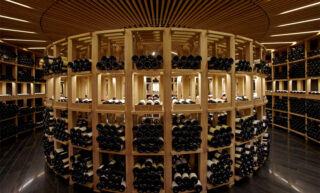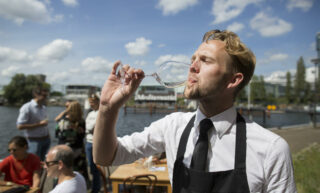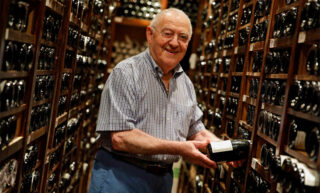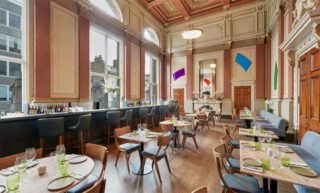The Art of Restraint
Although Logroño is the official provincial capital of La Rioja, Spain’s foremost wine region, Haro is historically the focal point for the wine trade. From here in the late 19th century, young wine was shipped by train to Bordeaux to compensate for the loss of grapes due to phylloxera, thus triggering La Rioja’s slow rise to fame. With its lively town square, its houses with pretty wooden bay windows and plenty of wine and tapas bars, Haro is an attractive base to explore La Rioja. However, it didn’t have the culinary reputation that one would expect of a town that is dubbed ‘the wine capital of La Rioja.’ With the opening of restaurant Nublo by a group of Mugaritz alumni this has changed dramatically.
Tucked away on a little square in the maze of small streets of Haro’s historical center, Nublo occupies a 16th-century palacio, or mansion, one of the town’s oldest buildings. It served as town hall, prison, police station and convent before Miguel Caño’s family bought it. Caño grew up in Haro, but his work and travels eventually brought him to San Sebastian’s Mugaritz, where he became the jefe de cocina, or kitchen chef, at the tender age of 32. But Haro pulled and he realized there was a gastronomical market gap to be filled.
Nublo's main dining room ©Nublo
Nublo opened its doors in July 2021 with a clear culinary vision: prepare contemporary dishes using the best raw materials while forgoing the modern commodities of gas and electricity, thus bridging the past and the future. In practice, this means the team of chefs only makes use of fire and embers (in the form of a wood oven, and a wood-fueled stove and grill) to prepare the ingredients. To be clear, this doesn’t imply all dishes are grilled or baked. Sous-vide cooking, for example, remains in the chefs’ toolbox, as we noticed in the succulent pigtail with fresh herbs.
Head chef Caño imposes further limitations by capping the number of ingredients per dish at three or four. As the Brazilian executive chef Caio Barcellos puts it: “When a dish is that simple, there is nowhere you can hide if the technique is not spot-on. We don’t have sauces, foams, or spherifications on the menu – every ingredient is almost naked. So, if things are not as close to perfection as possible, the dishes make no sense at all.”
The Germans would say: In der Beschränkung zeigt sich der Meister. And indeed, Barcellos and Caño don’t gild the lily.
These limitations may come to the fore most prominently in the sea bass with pilpil spinach, in which the pilpil was reduced to an emulsion of fish skin and olive oil, without the traditional red chili and garlic. It proved that when the produce is of the highest quality and prepared well, a dish doesn’t need many ingredients to be extremely flavorful.
Carabinero and Lime ©Nublo
His produce-focused approach and his stations in Catalunya and the Basque Country led Caño to cast his net wider than just La Rioja to find his ingredients. Thus, fish dishes like the aforementioned sea bass – but also shrimp with barbecued lime and hand-caught cuttlefish in its own ink – form an integral part of the menu and complement more locally inspired dishes such as trout with ham jelly or the chanterelle stew. Having only river fish from the Ebro to his disposal would be too limiting and would also mean Caño had to put up with farmed fish rather than wild, a constraint that would harm Nublo’s quest to work out the best possible flavor from their produce.
Refreshingly (and against the trend) at Nublo, slow cooking, fire and top-quality produce are more important than storytelling. Don’t expect fanciful, far-fetched fairytales about a beloved grandmother or theatrical capers at your table, but just the minimalistically (but beautifully) plated, purist dishes. With two tasting menus of 12 and 15 small courses respectively, there is no time for elaborate table-side rituals anyway. Pacing is key, and the kitchen and service teams succeed with flying colors. The Michelin star Nublo was awarded soon after its opening is very well deserved.
While the zero-kilometer concept was dismissed for the ambrosial part of the menu, the nectarean part consists almost completely of local wines. With transportation (of heavy wine bottles) by far the most environmentally damaging part of wine production and consumption, this is arguably one of the most impactful choices the Nublo team could have made. However, with the diversity of wines in La Rioja, it also is a no-brainer. Hence executive chef Barcellos doesn’t feel restricted by this limitation. He says: “Our sommeliers are always searching for local wines, new winemakers, and old vintages of classic Rioja wines, so that we have a large pallet to work with. That way, every time a new dish comes up, there are a lot of pairing options and the sommeliers taste for the best combination possible.” In other words, the dishes aren’t conceived with a particular wine as a starting point.
Restaurant Nublo's bodega ©Nublo
Having said that, wine takes center stage at Nublo. Before being led to the dining room, the diner is invited to descend into an eye-catching wine cellar. A small but artfully and efficiently designed stairwell lined with bottles of wine from all over La Rioja spirals down into the basement.
The collection is carefully put together by the two sommeliers, Bryan Solórzano and Rodrigo Miguel. Well-known names such as López de Heredia, CVNE, Marques de Murrieta, and Muga alternate with relatively new but established producers like Bodega Contador and Roda, and those representing the latest generation and trends like Cuenta Viñas, Elena Corzana and Alegre Valgañón. In that same vein, the sommeliers welcome the viñedos singulares or single vineyard wines as “a new way of conceiving Rioja wines…a new market…and more options for customers.”
Diverting from the food philosophy, Solórzano says: “For us it is essential that there is a story behind any type of wine. Because in that story you will find passion, sacrifice and the desire to offer something really unique and special.”
Our Qué bonito Cacareaba (vintage 2020), a white blend of viura, garnacha blanca and malvasia from Benjamin Romeo’s Bodega Contador, did exactly that. With 15 percent abv, it was potent and opulent, but elegant and perfectly balanced at the same time. Round acidity and a mesmerizing spectrum of aromas and flavors, ranging from beeswax via yeasty notes and melon to ripe yellow apples, lemon and lemon rind, led to a long, harmonious finish. For the earthier and meatier part of the menu, Solórzano served us an excellent and sleek single vineyard Tempranillo from GR99, a new winery founded in 2020 in San Vicente de la Sonsierra, one of the most important villages of La Rioja Alta, just east of Haro.
Benjamin Romeo's Qué bonito Cacareaba ©Bart de Vries
Solórzano and Miguel do not only scour the region in search of new projects, but they also bring the vintners to the restaurant, where they can meet with the press, buyers, other wine professionals and visitors to share ideas and discuss all things vinous. Or, as Isabel Bobadilla, the restaurant’s managing director says: “Winemakers of the region see us as an important ally in their relationship with visitors, clients and the industry in general, and that gives us a steady flow of people that come to the region for the wine, and now stay a little longer for the food.”
Within just two years, Nublo has become an essential stop on the Rioja trail, not only for its wide-ranging collection of local wines, but also for the less-is-more, pure-flavored and fire-driven dishes.








Comments